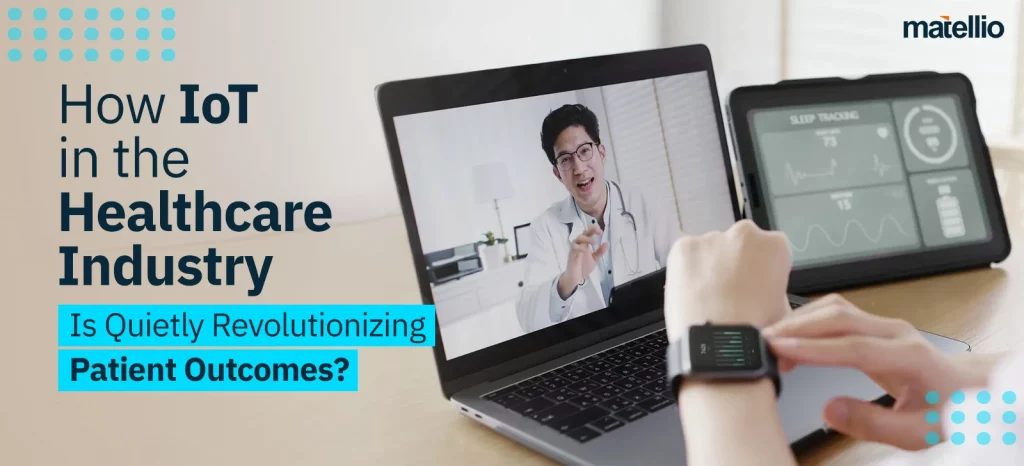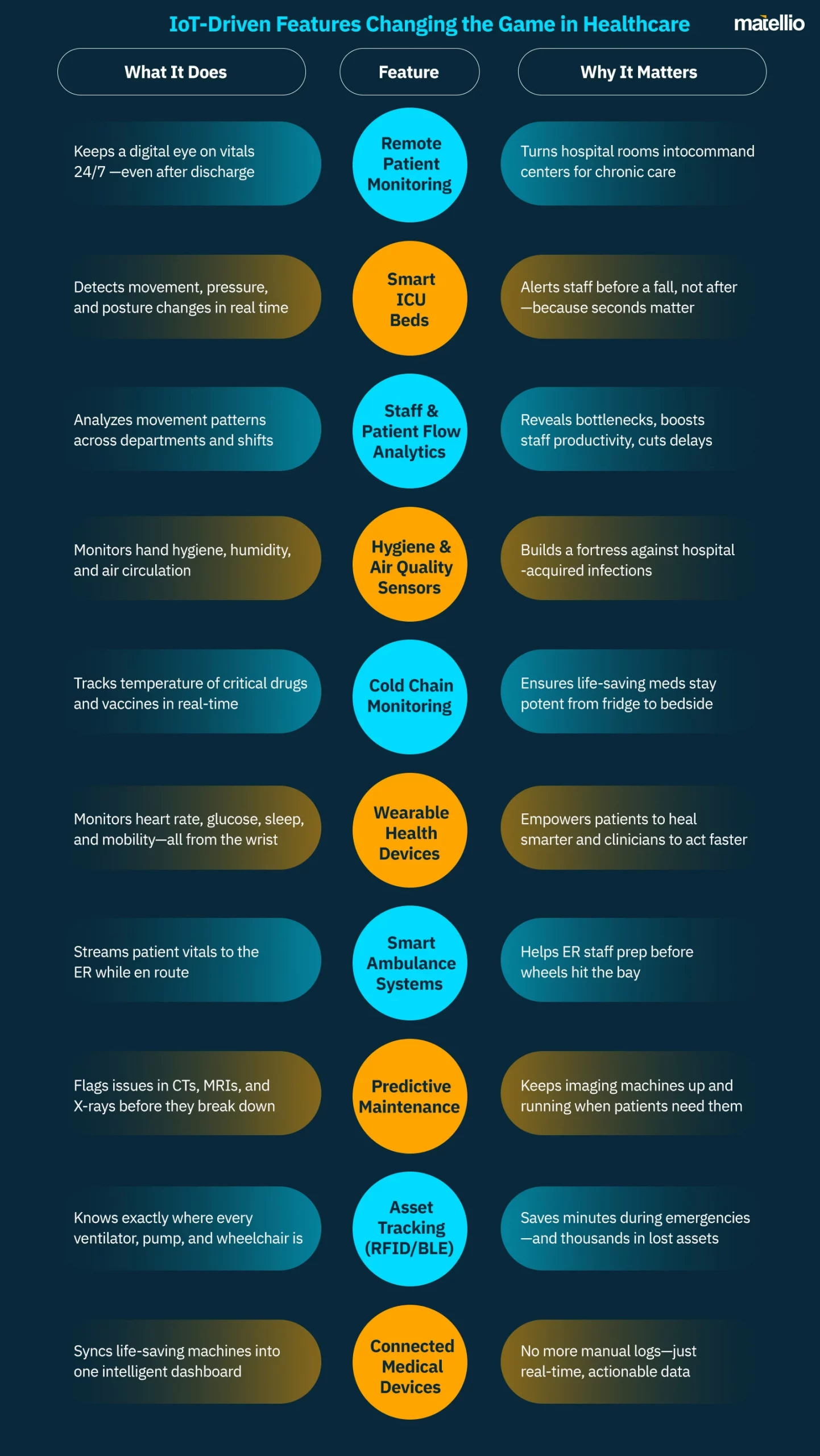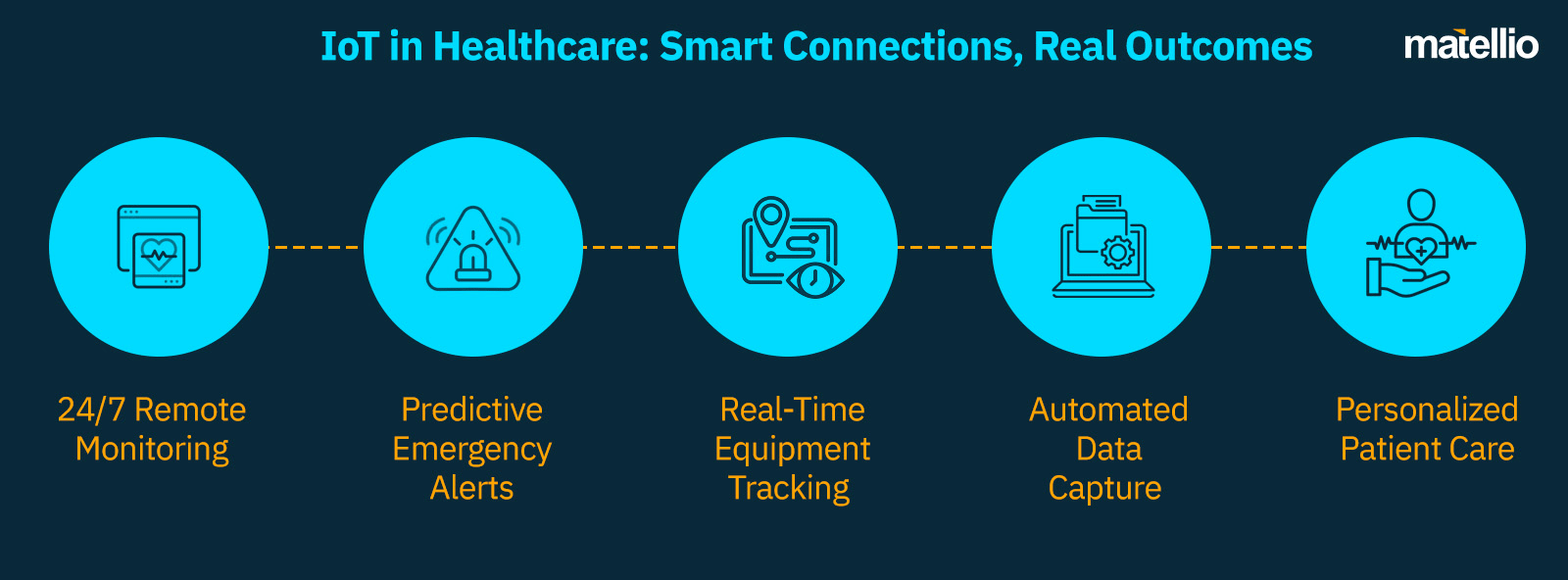
A patient arrives at the ER with chest discomfort. Vitals are recorded manually. Data is delayed. Action is slower than needed. The result? A critical window was lost. It’s a scenario still too common—and it highlights the urgent need for IoT in the healthcare industry to close these life-threatening gaps.
In today’s fast-paced care environments, delays in data and decisions are costing more than time—they’re costing outcomes. That’s where IoT is rewriting the script. From ICU automation to remote patient monitoring, it’s no longer a futuristic concept—it’s the blueprint for proactive, connected care.
By transforming disconnected processes into a smart, unified system, IoT helps providers shift from reactive firefighting to real-time, life-saving decisions. It’s not just about technology—it’s about enabling care that’s faster, safer, and future-ready.
Where IoT in the Healthcare Industry Becomes Non-Negotiable
Still relying on paper, pagers, and patchy systems? The reality is that many healthcare providers are operating in silos, using outdated tools that hinder rather than help. As patient expectations grow and clinical loads intensify, the cracks are only widening. Without IoT in the healthcare industry, these persistent pain points continue to drain resources, delay care, and diminish outcomes.
Let’s break down the core challenges IoT is built to solve:
Disjointed Patient Monitoring Systems
When vitals are tracked manually or across unconnected devices, critical changes in a patient’s condition often go unnoticed. This lack of real-time data sharing between departments delays interventions. Modern IoT Healthcare Solutions offer smart monitoring that bridges these gaps—enabling 24/7 oversight of critical data.
Delayed Diagnostics Due to Data Unavailability
Physicians often make decisions based on incomplete or delayed information. Waiting on lab results or imaging trapped in legacy systems increases diagnostic risks. This is where the advantages of IoT in healthcare shine—streamlining how and when data becomes available to the right teams.
Staff Burnout from Administrative Overload
Manual documentation, system-switching, and repetitive inputs burn out your workforce. Integrating IoT applications in healthcare reduces clerical load through automated logging and system syncing, freeing up clinicians for more face-time with patients.
High Readmission Rates
Discharged patients often lack structured post-care monitoring, which leads to avoidable complications and readmissions. Strategic implementation of IoT in healthcare enables proactive tracking through wearables and mobile health solutions, drastically improving recovery visibility.
No Predictive Insights for Emergency Readiness
From oxygen tanks to ICU beds, resource planning is still largely reactive. Predictive analytics powered by use cases of IoT in healthcare can forecast demand spikes and optimize resource allocation—saving both time and lives.
Fragmented Care for Elderly or High-Risk Patients
Senior citizens and high-risk patients often fall through the cracks in the absence of connected care. Emerging applications of IoT in healthcare now enable continuous monitoring, medication alerts, and fall detection, enhancing both safety and peace of mind.
Uncertainty About Long-Term Scalability
Some hesitate to invest without clarity on future returns. The future of IoT in healthcare lies in adaptive platforms—scalable systems that evolve with changing medical technologies and patient demands.
Lack of Visibility Into Proven ROI
Board-level stakeholders need assurance of returns before approving tech investments. Studying real-world IoT in healthcare examples—from smart hospital rooms to connected ambulances—can help make a convincing business case.
Willing To Build IoT-driven Healthcare Solution for Your Business Growth? The rise of IoT applications in healthcare is no longer confined to monitoring vitals or fitness wearables. Today, IoT has become the digital nervous system of modern hospitals—powering smarter diagnostics, safer procedures, and faster interventions across departments. Here’s how different wings of healthcare are tapping into the transformative potential of IoT. In high-pressure ER environments, knowing where critical equipment is located can save minutes—and lives. IoT-enabled RFID and BLE sensors track patient movement, ambulance arrivals, and the availability of crash carts, ventilators, and defibrillators. This results in faster triage, reduced wait times, and improved coordination during emergencies—one of the most vital use cases of IoT in healthcare that enhances both outcomes and operations. CT, MRI, and X-ray machines are capital-intensive and prone to downtime. IoT sensors embedded in imaging equipment continuously monitor performance, predict maintenance needs, and even auto-schedule repairs. This reduces downtime, enhances diagnostic throughput, and ensures 24/7 availability of essential machines—showcasing one of the overlooked challenges of IoT in healthcare: the need for seamless integration with complex hardware ecosystems. Cardiology units are leveraging IoT-powered wearables that track ECG, heart rate variability, and blood pressure in real time. These devices not only detect anomalies but also send automatic alerts to cardiologists and emergency teams—paving the way for preventive intervention before a crisis strikes. This advancement perfectly captures the benefits of IoT in healthcare—empowering clinicians with continuous visibility into patient health beyond the hospital walls. IoT sensors embedded in beds, IV pumps, and patient wearables allow round-the-clock remote monitoring of vitals. Advanced systems can even detect falls, seizures, or changes in breathing patterns—instantly notifying caregivers. This application is especially powerful in geriatric and post-operative care settings and serves as a powerful IoT in healthcare case studies for improving patient safety and minimizing manual intervention. Pharmacies within hospitals are using IoT to track medicine inventory levels, monitor refrigeration for temperature-sensitive drugs, and automate reordering. This ensures stock accuracy, reduces waste, and guarantees compliance with storage protocols—especially for vaccines, insulin, and biologics. These integrations illustrate the growing footprint of the internet of things (IoT) in healthcare market, which continues to expand as providers prioritize smarter infrastructure. Together, these applications are laying the groundwork for a connected, intelligent, and patient-centric healthcare ecosystem. Gartner projects that IoT spending by healthcare providers will grow from $16 billion in 2018 to nearly $52 billion by 2028, with chronic condition management leading the way at $28 billion in revenue growth, and hospital hygiene monitoring seeing the highest CAGR at 38%. These numbers are not just forecasts—they’re a signal. This is a signal that investing in IoT in healthcare industry isn’t optional—it’s essential for any businesses aiming to lead, not lag, in the next decade of care innovation. In healthcare, complexity is the norm—not the exception. Yet most off-the-shelf IoT platforms are built for uniformity. They assume every hospital operates the same way. But when generic tools meet intricate care systems, it’s the provider—and the patient—who lose. And in the ever-expanding IoT in healthcare industry, losing out on performance, speed, or accuracy is not an option. Off-the-shelf tools weren’t built for your care model—and it shows. At Matellio, we don’t sell generic tools—we engineer precision-driven systems through our IoT Development Services. Each solution is crafted to align with your infrastructure, clinical goals, and operational structure. Here’s what we’ve helped healthcare providers achieve: Every solution is designed from scratch—not retrofitted—so your system evolves with your workflows, not against them. At Matellio, we offer end-to-end implementation backed by deep domain expertise and compliance. Our process is designed to deliver scalable, secure, and interoperable solutions—purpose-built for the modern IoT in healthcare industry. With Matellio, you don’t just get IoT—you get a strategic partner who delivers connected care with clinical clarity, operational strength, and future readiness. Fill in the form to get started with Matellio’s expert-led IoT solutions. Top IoT Applications in Healthcare That Are Redefining Every Department
Emergency Department
Radiology
Cardiology
Inpatient Wards
Pharmacy and Inventory

Custom Is Critical: Off-the-Shelf Tools Don’t Cut It Anymore
Why Plug-and-Play IoT Falls Short in Healthcare
How Matellio Builds What Plug-and-Play Can’t

How Matellio Implements IoT in Healthcare Industry?


